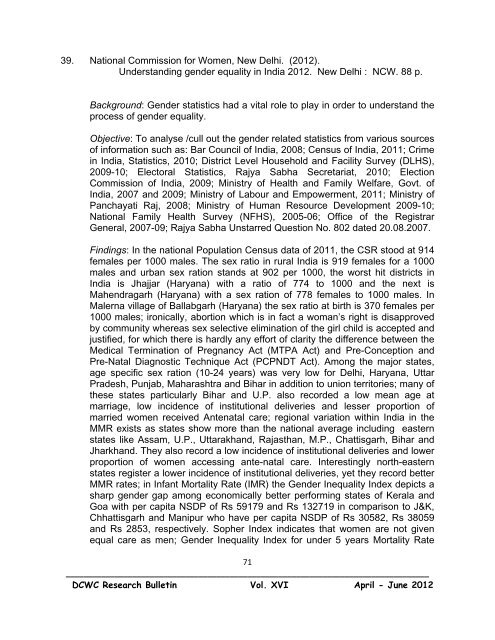Vol. XVI Issue 2 April - June 2012 2012 Documentation ... - Nipccd
Vol. XVI Issue 2 April - June 2012 2012 Documentation ... - Nipccd
Vol. XVI Issue 2 April - June 2012 2012 Documentation ... - Nipccd
Create successful ePaper yourself
Turn your PDF publications into a flip-book with our unique Google optimized e-Paper software.
39. National Commission for Women, New Delhi. (<strong>2012</strong>).<br />
Understanding gender equality in India <strong>2012</strong>. New Delhi : NCW. 88 p.<br />
Background: Gender statistics had a vital role to play in order to understand the<br />
process of gender equality.<br />
Objective: To analyse /cull out the gender related statistics from various sources<br />
of information such as: Bar Council of India, 2008; Census of India, 2011; Crime<br />
in India, Statistics, 2010; District Level Household and Facility Survey (DLHS),<br />
2009-10; Electoral Statistics, Rajya Sabha Secretariat, 2010; Election<br />
Commission of India, 2009; Ministry of Health and Family Welfare, Govt. of<br />
India, 2007 and 2009; Ministry of Labour and Empowerment, 2011; Ministry of<br />
Panchayati Raj, 2008; Ministry of Human Resource Development 2009-10;<br />
National Family Health Survey (NFHS), 2005-06; Office of the Registrar<br />
General, 2007-09; Rajya Sabha Unstarred Question No. 802 dated 20.08.2007.<br />
Findings: In the national Population Census data of 2011, the CSR stood at 914<br />
females per 1000 males. The sex ratio in rural India is 919 females for a 1000<br />
males and urban sex ration stands at 902 per 1000, the worst hit districts in<br />
India is Jhajjar (Haryana) with a ratio of 774 to 1000 and the next is<br />
Mahendragarh (Haryana) with a sex ration of 778 females to 1000 males. In<br />
Malerna village of Ballabgarh (Haryana) the sex ratio at birth is 370 females per<br />
1000 males; ironically, abortion which is in fact a woman’s right is disapproved<br />
by community whereas sex selective elimination of the girl child is accepted and<br />
justified, for which there is hardly any effort of clarity the difference between the<br />
Medical Termination of Pregnancy Act (MTPA Act) and Pre-Conception and<br />
Pre-Natal Diagnostic Technique Act (PCPNDT Act). Among the major states,<br />
age specific sex ration (10-24 years) was very low for Delhi, Haryana, Uttar<br />
Pradesh, Punjab, Maharashtra and Bihar in addition to union territories; many of<br />
these states particularly Bihar and U.P. also recorded a low mean age at<br />
marriage, low incidence of institutional deliveries and lesser proportion of<br />
married women received Antenatal care; regional variation within India in the<br />
MMR exists as states show more than the national average including eastern<br />
states like Assam, U.P., Uttarakhand, Rajasthan, M.P., Chattisgarh, Bihar and<br />
Jharkhand. They also record a low incidence of institutional deliveries and lower<br />
proportion of women accessing ante-natal care. Interestingly north-eastern<br />
states register a lower incidence of institutional deliveries, yet they record better<br />
MMR rates; in Infant Mortality Rate (IMR) the Gender Inequality Index depicts a<br />
sharp gender gap among economically better performing states of Kerala and<br />
Goa with per capita NSDP of Rs 59179 and Rs 132719 in comparison to J&K,<br />
Chhattisgarh and Manipur who have per capita NSDP of Rs 30582, Rs 38059<br />
and Rs 2853, respectively. Sopher Index indicates that women are not given<br />
equal care as men; Gender Inequality Index for under 5 years Mortality Rate<br />
71<br />
__________________________________________________________________________________<br />
DCWC Research Bulletin <strong>Vol</strong>. <strong>XVI</strong> <strong>April</strong> - <strong>June</strong> <strong>2012</strong>

















